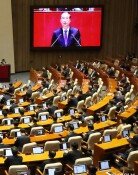Universities face crisis amid tuition freezes, falling number of students
Universities face crisis amid tuition freezes, falling number of students
Posted September. 26, 2016 07:09,
Updated September. 26, 2016 08:25
“As the government has been curbing universities from raising tuitions for more than five years, universities have no choice but to strive to secure funds from government subsidy programs. The fiasco in Ewha Womans University occurred for this reason.”
This is an analysis by a private university official in Seoul to explain the reason behind the internal conflict at Ewha Womans University where students continued sit-in protest for 60 days through Sunday. In the wake Ewha’s push to open a college of lifelong education, its students started protesting, saying, “Is the school trying to sell diplomas?” Even after the school withdrew the plan to introduce the lifelong education college, students have continued sit-in protest at the main building since July 28, calling for the resignation of the university’s president by citing lack of communications.
Ewha is not alone in trouble. Seoul National University is in dispute with its student council, as the school has sought to establish Siheung Campus focused on research, while Sookmyung Women’s University failed in its bid to allow admission of male students in the graduate school last year.
Sources have said this phenomenon is not a problem of just a few institutions. All universities and colleges are suffering from the "triple whammies" of a falling number of school-age population, competition over performance indicators and financial constraints. To overcome this crisis, a growing number of universities are seeking changes including establishment of new colleges, only to suffer setbacks in the face of student opposition.
The most direct cause for the crisis is freezing of college tuitions. Under law, universities are allowed to increase their tuitions by up to 1.5 times the inflation rate of the latest three years, but they could not raise tuitions for more than five years due to pressure by the education authority. Currently, four-year universities and two-year colleges have a total admission quota of 550,000 students per year, but the number of students graduating from high schools will decrease to 550,000 in 2018 and to 400,000 in 2023, respectively.
“The Education Ministry is directing universities and controlling education by handing out state subsides centered on programs that it wants, after imposing financial restrictions to schools by freezing tuition fees,” the education community say.
김도형 dodo@donga.com·최지연







